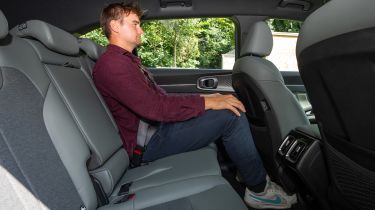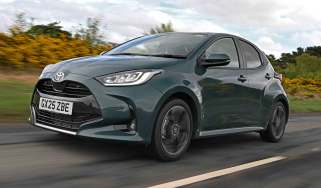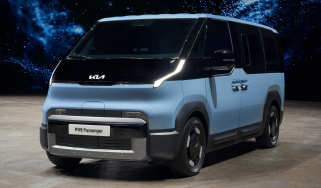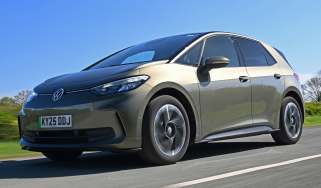Kia Sorento - Practicality, comfort & boot space
Lots of space and features focused on everyday usability make the Sorento a fine family car option

Cabin space is the Kia Sorento’s greatest strength, it makes good use of its sizable exterior dimensions, translating them into a spacious and user-friendly cabin. There’s generous space for four adults, and the two extra seats in the back are more comfortable than you’ll find on many rival seven-seaters.
Storage space isn’t in short supply, either, because there’s plenty of room in the centre console with cup-holders and a large area for charging devices. Speaking of charging, there are loads of USB sockets all over the cabin, with one for every occupant to keep their device topped up.
In the middle row, occupants get individual cup-holders in the door plus a second cubby lower down that could hold a drinks bottle. The centre armrest has more cup-holders, too, but because the middle seat is a little narrow this is probably best used as an armrest. The hybrid models position their batteries under the cabin floor, so there’s minimal boot-space penalty on these Sorentos compared with the diesel. The middle row also slides forward to allow for easy access to the third row.
Size
This is a big vehicle, but it’s not up there with the largest seven-seat SUVs on the UK market. The Kia Sorento is 1,700mm tall, 4,815mm long and 1,900mm wide, which is longer and slightly wider than a Skoda Kodiaq (4,699mm and 1,882mm). It’s also significantly longer than the 4,597mm Land Rover Discovery Sport, but smaller than the full-size Land Rover Discovery (4,956mm long and 2,000mm wide).
Leg room, head room & passenger space
The cabin generally feels spacious, and there is plenty of head and legroom for adults in the second row, even sitting behind a tall driver. The floor is flat, so there’s space for the feet of a middle-seat occupant, but the centre seat itself is narrow meaning only small children could use it for any length of time.
Used - available now

2019 KIA
Sorento
52,138 milesAutomaticDiesel2.2L
Cash £20,600
2022 KIA
Sorento
22,610 milesAutomaticDiesel2.2L
Cash £32,500
2017 KIA
Sorento
91,324 milesManualDiesel2.2L
Cash £10,999
2022 KIA
Sorento
51,703 milesAutomaticPetrol1.6L
Cash £27,851When we pitted the Sorento against a Nissan X-Trail we found the Kia does a much better job of accommodating seven. Access is much easier; the middle seat back electrically drops and slides forward at the touch of a button, and the gap to climb into row three is larger. The third-row seats are fine for kids, and adults can fit into the rear seats, but with thighs tucked up with the high floor they won’t want to spend too long back there. At least Kia has included ventilation controls and USB charging points for third-row occupants to use.
As long as middle-row passengers are willing to sacrifice some space, the Sorento has an extra 100mm of kneeroom over the X-Trail, and similar headroom. However the seat bases are close to the floor, which means your thighs are forced upwards and away from the cushion.
Boot
There’s an 813-litre boot in the Kia Sorento with the third-row seats folded down, and that drops to 809 litres in the plug-in hybrid. The amount of space is competitive for the class, and if you drop all the seats in the second and third rows, you’re looking at 1,996 litres (1,988 litres in the PHEV).
Even with the Sorento’s third-row seats raised, there’s still luggage space behind measuring 179 litres. You could fit a couple of holdalls back there, or a row of shopping bags. It’s also still possible to make use of the plastic-lined compartment under the boot floor that would be handy for muddy boots or similar. The second-row seats can be flooded down at the touch of a button from the boot area.
Towing
If you want to tow with a Kia Sorento, the diesel model offers a 2,600kg braked-trailer towing capacity with a maximum towball weight of 100kg. The petrol-hybrid models can manage significantly less, with the standard 1.6 T-GDi capable of towing 1,110kg and the plug-in hybrid 100kg down on that at 1,010kg. A Trailer Stability Assist function is standard on all models.











